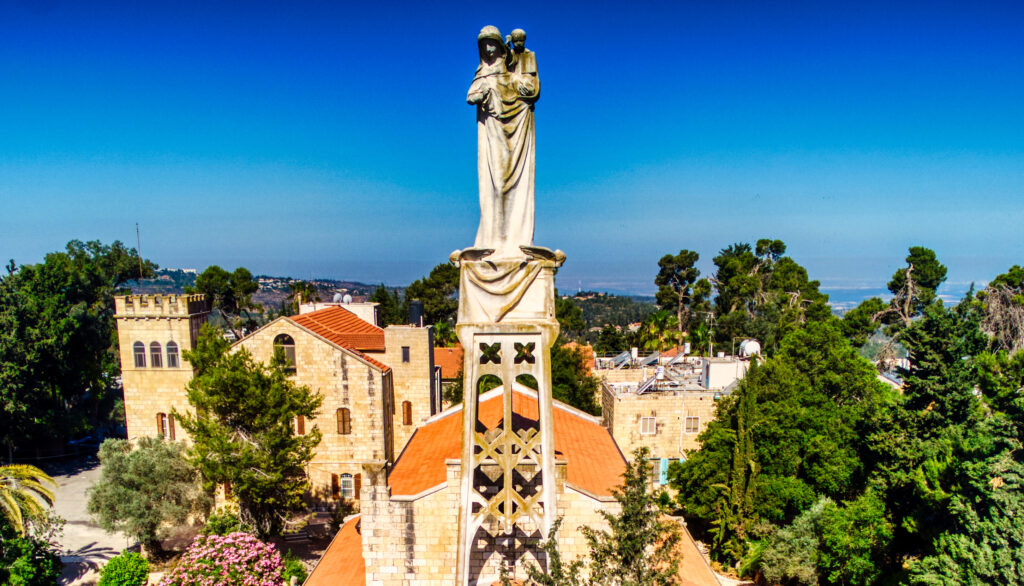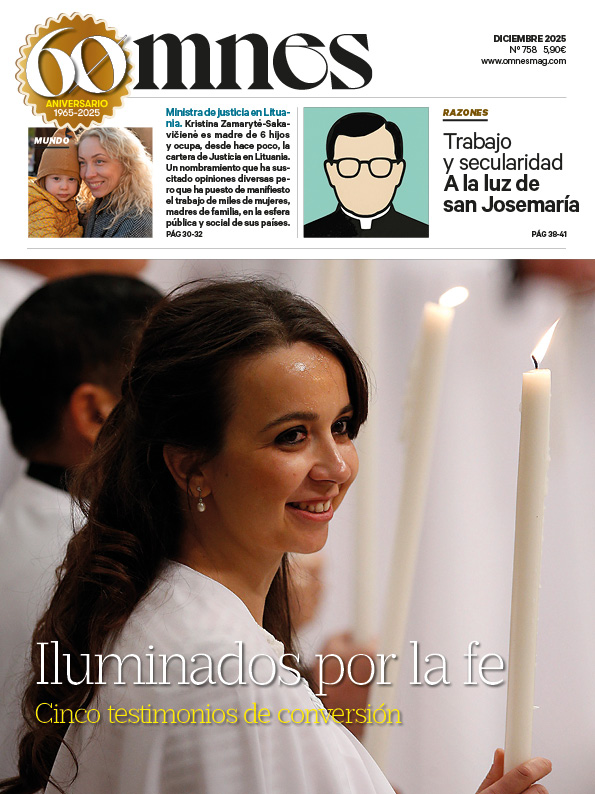The interpretation of Mary in the book of the Apocalypse of John, specifically in chapter 12, has been a central theme in Catholic exegesis. We will try to explain the idea that Mary is the woman symbolically represented as the Ark of the Covenant, based on some biblical, patristic and theological analyses.
1. Mary as the Woman of the Apocalypse and the Ark of the Covenant
Chapter 12 of the Apocalypse describes a vision of "a great sign in the sky, a woman clothed with the sun, with the moon under her feet and a crown of twelve stars upon her head"(Revelation 12:1). This woman has traditionally been interpreted in various ways, but within Catholic exegesis, she is seen as a representation of the Virgin Mary.
Furthermore, in Revelation 11, 19, just before the appearance of this "woman", it is mentioned that ".the temple of God which is in heaven was opened, and the ark of his covenant was seen in his temple" (Revelation 11:19). This reference to the ark has been seen by many theologians as an indication of the symbolic connection between the Old Testament ark of the covenant and Mary, who is considered the new ark, since she carried Christ in her womb, the very presence of God among men.
Indeed, just as the ark of the Old Testament contained the tables of the law, the manna and Aaron's rod., Mary contains the Word of God incarnate, the bread of life and the eternal priest, Jesus Christ. St. John, in revealing the ark in heaven, shows us that the ark of the new covenant is Mary, the vessel chosen to bring to the world the new and definitive covenant of God with humanity.
2. Biblical foundations of symbolism
The comparison of Mary with the Ark of the Covenant is based on several biblical quotations.
In the Old Testament, the ark was the place where God's glory resided,
John 1:14:"And the Word became flesh, and dwelt among us, and we beheld his glory, the glory as of the only begotten of the Father, full of grace and truth."This verse speaks of the Incarnation, where the Word becomes flesh and dwells among us. The Greek word used for "inhabited" is "eskēnōsen", which literally means "he pitched his tent", evoking God's presence in the tabernacle (ark) in the wilderness. Mary is seen as God's new dwelling place, the new "tent" where God's glory is manifested..
In 2 Maccabees 2:4-8, it is narrated that Jeremiah hid the ark before the exile, and that ".the site will remain unknown until God gathers his people and is propitious to them."(2 Maccabees 2:7). This context prepares the arrival of Mary, who becomes the new ark, bearer of the new covenant in the figure of Jesus, of whom it is said, "He is the brightness of the glory of God." (Hebrews 1:3)
Luke's Gospel also reinforces this image: "The Holy Spirit will come upon you, and the power of the Most High will overshadow you." (Luke 1:35). This verse recalls to the cloud that covered the ark in Exodus (Exodus 40:34-35), suggesting that. Mary, covered by the shadow of the Holy Spirit, is a figure that fulfills (and transcends) the role of the ark..
These other quotations also reinforce Mary's identification with the Ark of the Covenant and her role in the new covenant,
Psalm 132:8: "Arise, Lord, and come to your rest, you and the ark of your power." This quote connects the ark with the presence of God, which can be applied to Mary as the new ark that carries God Himself in its bosom. The invitation to God, "come to your rest"can also be seen as a prefiguration of the Incarnation.
Jeremiah 31:31-33: "Behold, the days are coming, says the Lord, when I will make a new covenant. with the house of Israel and with the house of Judah (...) But this is the covenant that I will make with the house of Israel after those days, says the Lord, I will put my law in his mind and write it on his heart; and I will be their God, and they shall be my people." This prophetic passage speaks of a "new covenant" which will be fulfilled in Christ, who is carried in Mary's womb. Mary, in this context, can be seen as the ark that carries not only the Law (like the ark of the old covenant) but the very Word made flesh.
2 Samuel 6:9-12: "How shall the ark of the Lord come to me? [And it came to pass from the day that the ark remained in the house of Obededom until the day that David brought it into the city of David, the Lord blessed the house of Obed-edom." This passage recalls the visit of the ark to Obed-edom's house, which resulted in blessing for him. Similarly, Mary's visit to Elizabeth in Luke 1:39-45 results in a blessing for Elizabeth, underlining the connection between the ark and Mary as the bearer of divine blessing..
2 Samuel 6 and Luke 1. The parallel is striking between the story of David's bringing the Ark to Jerusalem and the story of Mary's visit to Elizabeth. The story begins with David "arose and went." (2 Sam 6:2). Luke's account of the visitation begins with the same words, Mary "got up and went". (1, 39). On their respective journeys, Mary and David headed for the region of mountainous region of Judah. David recognizes his unworthiness with the words "how can the ark of the Lord come to me?" (2 Samuel 6:9)... words that we find repeated when Mary approaches her relative Elizabeth, "...".Whence to me, that the mother of my Lord should come to me?" (Luke 1:43). Notice that the phrase is almost literal, except that "ark" is replaced by "mother". Further on we read that David "danced" for joy in the presence of the ark (2 Samuel 6:14,16), and we find that a similar expression is used to describe that the child leaped in Elizabeth's womb when Mary came near. (Luke 1:44). Finally, the ark remained in the mountains for three months (2 Samuel 6:11), the same time Mary spent with Elizabeth (Luke 1:56).
Revelation 12, 5: "And she brought forth a man child, who is to rule over all nations. with a rod of iron; and his son was caught up to God and to his throne." This verse of Revelation refers to the son of the woman (Mary), identifying him with Jesus, who fulfills the messianic prophecy. The connection between this woman and the ark of the covenant in the previous verse reinforces the identification of Mary with the ark.
Hebrews 9:4-5In the ark there was a golden urn which was contained the manna, Aaron's rod that budded, and the tables of the covenant. And above the ark, the cherubim of glory, which covered the mercy seat." The ark contained sacred elements that foreshadowed Christ, the manna (bread of life), Aaron's rod (priestly authority) and the tablets of the Law (the word of God).. Mary, as the new ark, contains Christ, who is the bread of life, the high priest and the incarnate Word.
3. Patristic commentaries and Marian theology.
The Church Fathers also interpreted Mary as the Ark of the Covenant. St. Ambrose, for example, in his commentaries, he speaks of Mary as the bearer of the new law in Christ, making a parallel with the ark that contained the tables of the law given to Moses. This symbolism was later developed in medieval and modern theology.
John Henry Newman, in his work Mary, The Second EveNewman also reflects on this identification, arguing that just as the ark contained the sacred objects of the covenant, Mary carried in her womb the Son of God, the fulfillment of the covenant. For Newman, Mary is thus the living ark, the perfect tabernacle of divinity.
4. Contemporary Applications
In contemporary theology, authors such as Scott Hahn at Hail, Holy Queen have popularized this interpretation, showing how Revelation reveals the full glorification of Mary in heaven, reflecting her role as the ultimate ark of the covenant. Hahn argues that the appearance of the ark in Revelation 11:19 followed immediately by the vision of the woman in chapter 12 is not a coincidence, but a revelation of the continuity and fulfillment of salvation history.
5. Conclusion, Mary and the mystery of the Covenant
The identification of Mary with the Ark of the Covenant in the Apocalypse of St. John is a rich theological image that connects the Old and New Testaments. Through biblical quotations and patristic commentaries, we can see how this interpretation has been developed over the centuries. Mary, as the new ark, not only carries Christ, but also represents God's new covenant with humanity, an eternal covenant sealed with love and redemption.
This Marian vision has profound implications for Christian spirituality, especially in the veneration of Mary as the Mother of God and the first disciple of Christ, whose life and mission are intimately linked to the mystery of salvation revealed in the Scriptures.
In the Catholic Church, when celebrating this mystery of Mary in the liturgy of the Assumption of Mary, texts evoking these mysteries are used,
1st Reading, Revelation 11:19a; 12:1-6a, 10ab: which we have already discussed above, is central to the liturgy of the Assumption. The identification of the ark with the woman "clothed in the sun"has traditionally been interpreted by the Church as an image of Mary. The reference to the ark connects directly with the idea of Mary as the new ark, the bearer of God's presence in the person of Jesus..
The Psalm 44 (45), 10-12, 16: who celebrates the entrance of the Queen into the King's palace with great joy and honor. A reference to the glorification of Mary, recognized as Queen of Heaven (Benedict XVI, on the head of the woman clothed with the sun there are "a crown of twelve stars". This sign symbolizes the 12 tribes of Israel and signifies that the Virgin Mary is at the center of the People of God, of the entire communion of saints.). The figure of the Queen associated with the Ark of the Covenant in the temple reinforces the image of Mary as the dwelling place of God and the Mother of the King of Kings.
2nd Reading, 1 Corinthians 15, 20-27In this passage, St. Paul speaks of the resurrection of the dead and the primacy of Christ over death, "For as in Adam all die, even so in Christ shall all be made alive. But each one in their order, Christ, the firstfruits; then, those who are Christ'sat his coming" (1 Corinthians 15:22-23). This passage resonates with the doctrine of the Assumption, which holds that Mary (the first fruits), as the first to be redeemed by Christ, is also the first to share fully in his victory over death.
Gospel, Luke 1, 39-56 (The Visitation and the Magnificat). In this passage, Elizabeth is filled with the Holy Spirit and recognizes in Mary the Mother of God, evoking the respect and veneration that David showed for the Ark in 2 Samuel 6. The Magnificat song reflects the joy and exaltation of Mary's humility, who carries in her womb the Savior of the world. The "shadow of the Most High" that covers Mary at the Annunciation (Luke 1:35) is similar to the cloud that covered the ark at the Exodus, again underscoring her role as the new ark.
Doctor of Canon Law







